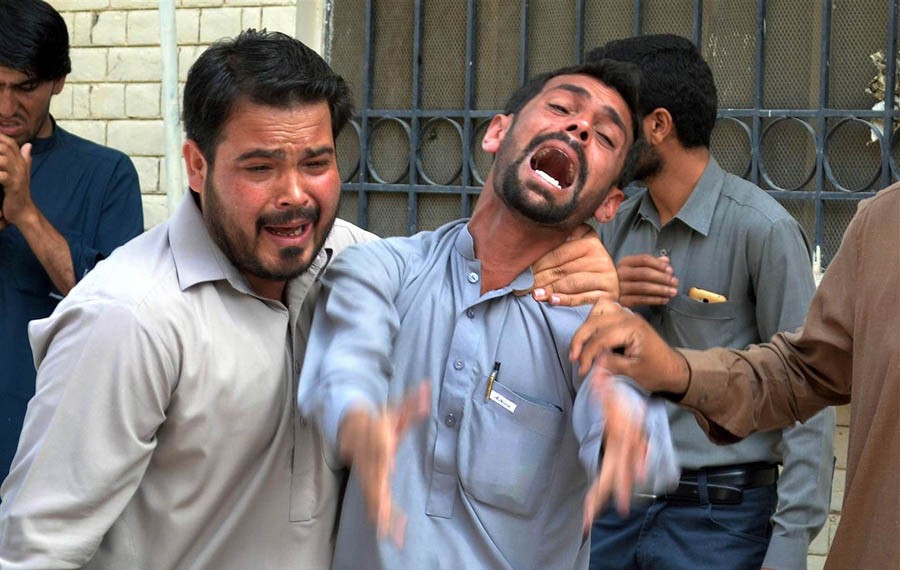
A set of focused strategies is needed without delay to deal with incidents of violence

After a few months of the Civil Hospital attack on the lawyers, the police trainees in Quetta became the victims of a deadly terror attack during October 2016. The city has been under serious security threats for quite some time.
Attacks on the Shia Hazara community from time to time prove that much more is desired to make the city function normally. Direct outcomes of these incidents have caused an enhanced focus on security administration, exponentially rising cost of doing business in Quetta and other towns in Balochistan. According to former chief minister, Sardar Akhtar Mengal, despite spending Rs30 billion on security, little relief is achieved in the province.
We are told that all possible measures are being taken for paving the way for China Pakistan Economic Corridor (CPEC). But rising terror incidents demand a detailed appraisal of the situation. A set of focused strategies is needed to deal with such incidents of violence without delay.
The first step in the formulation of such strategies is to take stock of the existing situation on the ground from an objective standpoint. From the common observations, media reports and research studies, it is well known that almost all the major political and interest groups condemn terrorism. However, there are many differences about the perceptions and understanding about the roots, spread and impact of terrorism.
Unless a dialogue for building a consensus on weeding out terrorism and its causes is not fostered on a continuous basis, efforts of containing it will not bear any worthwhile result. This consensus is also important to check hard liners, militants and rogue elements within religio-political parties and interest groups.
A review of the political landscape in Balochistan shows that many of such groups have clandestine agenda of their own which often causes immense harm to the parties they belong to and the peace and tranquillity in the society. Banned outfits, such as those which claimed responsibility of Police Training Centre attack, have had a rather comfortable presence for many years. Terror planners and their recruits do not descend from the skies -- they are to be found from the ranks of folks already involved in crime and anti-social activities.
The second step is to study the financial network that supports terror planners and their activities. No terror network can succeed in its nefarious designs without mobilising the financial means. Intelligence sleuths and banking experts in the relevant field may be engaged to piece together the available information to prepare a counter strategy for blocking dubious transactions. It may be understood that this is an extremely demanding task.
Expanded cash economy in Balochistan, clan protections to terror supporters, invisible and coded nature of transactions, international and local patronages and many similar factors can be major hurdles. A large cache of currency found in the house of a bureaucrat in Quetta some time ago proves the point. The local knowledge about all kinds of money transactions can be relied upon. Remittances through the illegal channels such as ‘hundi’, ‘parchi’ and ‘havala’ are obvious cases in point. The crime investigation experts may be invited to focus on the various unresolved dimensions of acquisition, transactions and distributions of funds across terror enterprises.
Fortification and scientific monitoring of vulnerabilities is the third step. Urban contexts in Balochistan have several types of vulnerabilities which become extended liabilities in combat against terrorism. Irregular settlements and absence of an organised urban growth and development are the foremost concerns.
Most of the inner city settlements in Quetta, Turbat and Gwadar have congested narrow lanes with very limited access for any kind of relief work. Shoddy construction, convoluted electric wiring and haphazard infrastructure constitute a perpetual hazard. The spread out terrain of Balochistan merits a strategic use of electronic and robotic technologies to monitor the situation. Effective monitoring of city entry points is also a vital consideration.
At the operational side, experts believe that terror attacks can best be dealt through pre-emption. Once a terrorist is set in motion, death and destruction follow. The rational way is to strengthen the process of locating hideouts and accomplices through surgical and precise operations to avert mass destruction. Disappointingly, one finds that orthodox means of blockading the thoroughfares and manual searches are made to deal with the scenario. Recourse should be made towards appropriate technology of mapping, monitoring and targeting concurrent actions. The support of relevant tools of information technology may be acquired. On the basis of available information and data base, a broad based crime information system can be electronically produced and shared amongst the concerned stakeholders. Inputs from media correspondents, academia, technologists, IT professionals and law enforcement agencies can also be mobilised.
Cities in Balochistan, particularly Quetta, can adopt the tested model of Citizen Police Liaison Committee where technology and collaborative efforts of citizens has borne fruit. The ordinary citizens feel comfortable to link up to institutions like CPLC. If a multi-stakeholders forum is generated in Quetta with facilitation from the government, it can prove very useful.
Another core issue is to respond to the emerging needs and compounding trauma of terror victims in Quetta, especially the economically downtrodden groups. In many cases, the injured, widows and orphans constitute a sizable portion of affected target groups that require continuous assistance in rehabilitation. Many people who are faced with lifelong disabilities as a consequence of attacks lose hope and develop frustrations. Ordinary and specialised healthcare is the foremost necessity in these situations.
Public sector healthcare facilities have performed exceptionally well in minimising the agonies and trauma of such heinous acts, their meagre resources and capacities notwithstanding. Monetary and insurance incentives must be extended to those medical practitioners and paramedical staff who have served under most adverse circumstances in locations such as Marriabad in Quetta. Certain units and fields of specialisation like burns units and trauma care must be bolstered. Common observations prove that blast victims suffer from burn injuries of very serious nature.